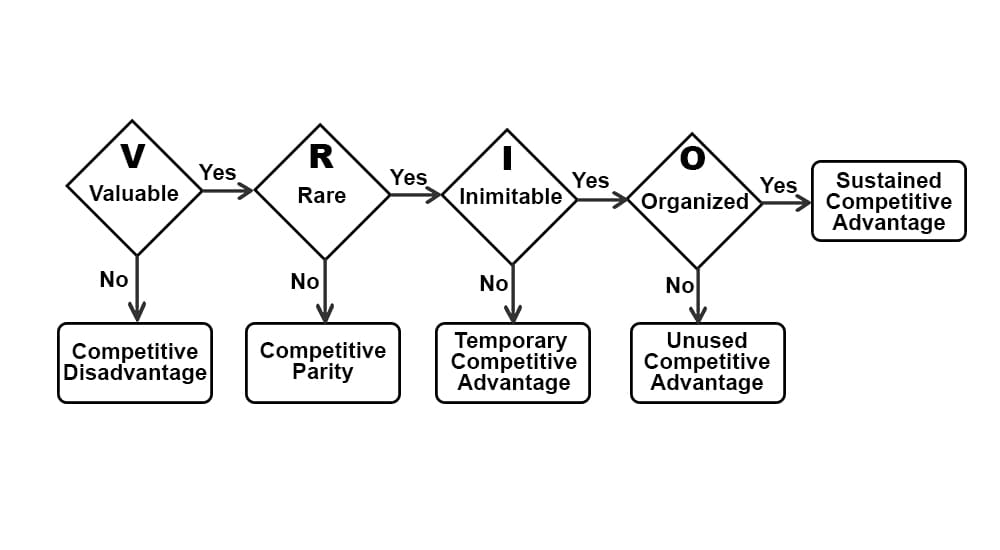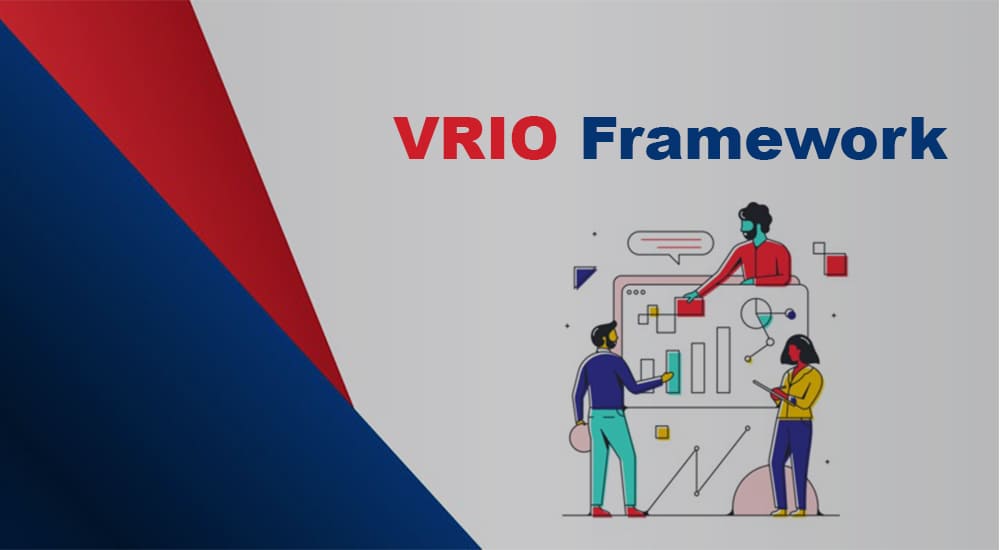Businesses have many tools to scan external environments, such as PESTLE Analysis, Porter’s Five Forces, and other tools to analyze internal environments, such as value chain analysis and BCG Matrix.
However, none of these tools help organizations safeguard their intellectual property and processes. In such situations, VRIO Frameworks come to the rescue. Barney, J.B. developed this tool in 1991.
The VRIO Framework is a strategic planning tool that lets organizations protect their business and provide an edge over competitors. It safeguards a business and ensures competitors cannot copy the organization’s business model.
A “business competitive advantage” allows a business to be more successful than its competitors. If a business model is not protected, this is a huge risk, and the business’s reputation could be damaged. There is a chance that copying practices can become acceptable if ignored.
That is why the VRIO Framework is important.
The VRIO Framework lets businesses leverage their advantages, which can be used as an edge over competitors.
This article will provide details of the VRIO analysis, its advantages and disadvantages, and how to use the VRIO Framework to improve business operations.
VRIO Framework
VRIO stands for Value, Rarity, Imitability, and Organization. It is an analysis used as a template for measuring business successes. The VRIO Framework puts together the business’s resources and abilities and secures the competitive advantages the business has over its competitors.
The VRIO Framework identifies businesses’ competitive edge and shows them how to use these advantages to grow further. Understanding the VRIO Framework ensures that businesses capitalize on their competitive edge, which can be used to create a lasting and sustainable business.
Businesses want unique services for their customers. The VRIO Framework helps businesses generate long-lasting, sustainable success and allows them to stay relevant in a highly competitive market.
Elements of the VRIO Framework
The VRIO Framework is gaining popularity, and now even startups are adopting it.
To use the VRIO analysis, the first step is to identify the VRIO elements for the organization.
The five VRIO elements are as follows:

Value
Businesses must identify the key resources that are adding value to the product or service.
Identifying value makes it easier to manage and guide the business activities and goals toward giving customers the best experience.
A valuable resource has to be reviewed for its value regularly, as changes in market conditions make it less valuable.
Rarity
If a resource is available to a few organizations, it is rare. Rare resources are a temporary advantage to an organization. This element ensures that businesses can preserve their competitive edge and guard it against competitors.
Businesses should identify their rare operational features and search for ways to integrate them into offering better products and customer service.
Imitability
It is competitors’ ability to copy a business’s solution with their available resources.
If the business processes can be easily duplicated, it is better to either change them or increase their value to make them unique and make copying more difficult.
This element checks if competitors can easily copy or duplicate their business operations and provide measures to stop such an event from occurring.
Organization
This element deals with analyzing an organization, its structure, workflow, business model, workflow, etc., and finds how it can provide a competitive advantage. Here, a business can check weak factors and find ways to use them as a competitive edge against its competitors.
SWOT Analysis Vs VRIO Framework
SWOT analysis and the VRIO Framework have some similarities. Both are helpful planning tools and offer enormous benefits.
Here are a few key differences between VRIO and SWOT.
SWOT Analysis
- Examines internal abilities and weaknesses as well as external strengths and opportunities.
- This tool can assist in assessing potential prospects.
- Examines the advantages and disadvantages of the strategic plan.
- The analysis is easy to understand.
VRIO Analysis
- Concentrates on internal performance measures and conditions that affect the competitive edge.
- Focuses on factors that can deliver the best results or break a company.
- Provides a deep understanding of the uniqueness of an organization and the competitive environment.
- Concentrates on the resource base instead of overall areas of strength, resulting in very concrete solutions.
How to Use the VRIO Framework
The following steps are required to use the VRIO analysis.
Step 1: Determine Rare, Expensive, and Difficult to Copy Resources
Businesses have tangible and intangible resources.
Tangible resources can be available on the market, and they are not rare resources.
Intangible resources are the company’s trademarks, such as intellectual property, training systems, and employee work systems. These are rare competitive resources and represent a competitive cost advantage to replicate.
Step 2. Use Organizational Resources Efficiently
There are different ways to discover whether a business can exploit its resources and make good, lasting use of them.
The business can start by comparing the strategic management processes, the reward systems, the business environment, organization structure, etc., and improve them if there is any weakness. Identify idle resources and use them to the business’s advantage.
Step 3: Safeguard the Resources
Identify business resources and define protective guidelines. The resources that provide a competitive advantage must be protected from duplication and unlawful usage by competitors.
Making the resources difficult to imitate is a strong defense and is a competitive advantage.
Step 4. Monitor VRIO Resources Regularly
The value of assets can change with time. They should constantly be assessed for their value, as rivals can attempt to gain the same competitive edge to duplicate the assets and steal the market share.
As soon as competitors duplicate such resources, they are no longer competitive advantages.
VRIO Framework Example
An example of Google using VRIO elements is given below.
- Value: Google invites and employs personnel by using human capital management data. This helps them effectively manage employees’ productivity and value rate.
- Rarity: Google uses a data-based employee management system for its operations. It is unique and different from any other software used by its competitors.
- Imitability: The use of the data-based employee management system by Google is expensive and unique, making it extremely difficult to imitate. This gives the company an edge.
- Organization: Google is structured, and it can derive value from this functionality. The IT department is equipped to organize and manage the information. HR and group leaders are taught how to use statistics to employ, promote, handle, and improve employee performance.
Pros and Cons of VRIO
Here are some advantages and disadvantages of the VRIO Framework.
Pros
- The VRIO Framework is useful in prioritizing the allocation of business resources.
- It is a useful tool that can identify internal resources and competitive advantages.
- The VRIO Framework allows businesses to identify the unique features necessary for success.
- The VRIO Framework helps businesses identify the most effective and vital factors in establishing and sustaining a competitive edge.
- The VRIO Framework makes it easy for businesses to identify their competitive edge and safeguard their processes and assets from imitation.
Cons
- The VRIO Framework cannot predict a business value and competitive edge over a long period.
- Smaller businesses find difficulties in identifying VRIO Framework elements.
VRIO analysis should be performed before developing the strategic plan. This helps shape the vision and create a vision statement.
The VRIO Framework complements the SWOT analysis. The “Strengths” section should include the discovered competitive advantages.
The VRIO Framework and SWOT analysis are critical components of the strategic planning process. Many businesses use these strategic frameworks to help convert their tactics into actionable plans.
Conclusion
Organizations strive for competitive advantage and safeguard their business models. The VRIO Framework is an important tool to help businesses achieve these objectives and ensure success. Businesses can use this framework company-wide or for individual business units.
